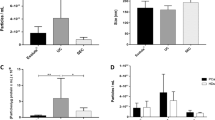Abstract
The presence of approximately 200-bp cell-free DNA (cfDNA) in the urine has attracted attention as a biomarker for liquid biopsy. However, it is currently useful only for diagnoses of cancers in which a large amount of cfDNA is excreted in the urine. Therefore, the development of an efficient method for extracting cfDNA existing in small amounts in the urine is essential for diagnosing many other diseases. We examined the effect of particle size, small pore size (surface area), and surface modification of porous silica particles on the efficiency of DNA extraction. Our observations suggested that cfDNA could be captured by tertiary amine–modified particles and then removed from the particles by repeatedly washing with sodium bicarbonate (pH 11). Using this method with 30 mg of triamine-modified particles, we succeeded in extracting a few hundred nanograms of cfDNA from 15 mL urine. Furthermore, we could detect ~ 67 fg/mL caries DNA (211 bp) in 15 mL urine sample, suggesting that this method may be suitable for the extraction of genetic biomarkers for cfDNA-based liquid biopsy.




Similar content being viewed by others
References
Toyo'oka T. Diagnostic approach to disease using non-invasive samples based on derivatization and LC-ESI-MS/MS. Biol Pharm Bull. 2016;39:1397–411.
Adamczyk B, Tharmalingam T, Rudd PM. Glycans as cancer biomarkers. Biochim Biophys Acta Gen Subj. 1820;2012:1347–53.
Baranova A, Lal P, Birerdinc A, Younossi ZM. Non-invasive markers for hepatic fibrosis. BMC Gastroenterol. 2011;11:91.
Link A, Balaguer F, Shen Y, Nagasaka T, Lozano JJ, Boland CR, et al. Fecal microRNAs as novel biomarkers for colon cancer screening. Cancer Epidemiol Biomark Prev. 2010;19:1766–74.
Su YH, Wang MJ, Brenner DE, Ng A, Melkonyan H, Umansky S, et al. Human urine contains small, 150 to 250 nucleotide-sized, soluble DNA derived from the circulation and may be useful in the detection of colorectal cancer. J Mol Diagn. 2004;6:101–7.
Zhang LH, Dang FQ, Kaji N, Baba Y. Fast extraction, amplification and analysis of genes from human blood. J Chromatogr A. 2006;1106(1–2):175–80.
Botezatu I, Serdyuk O, Potapova G, Shelepov V, Alechina R, Molyaka Y, et al. Genetic analysis of DNA excreted in urine: a new approach for detecting specific genomic DNA sequences from cells dying in an organism. Clin Chem. 2000;46:1078–84.
Su YH, Wang MJ, Block TM, Landt O, Botezatu I, Serdyuk O, et al. Detection of mutated K-ras DNA in urine, plasma, and serum of patients with colorectal carcinoma or adenomatous polyps. Ann N Y Acad Sci. 2008;1137:197–206.
Decramer S, de Peredo AG, Breuil B, Mischak H, Monsarrat B, Bascands JL, et al. Urine in clinical proteomics. Mol Cell Proteomics. 2008;7:1850–62.
Wu LL, Chiou CC, Chang PY, Wu JT. Urinary 8-OHdG: a marker of oxidative stress to DNA and a risk factor for cancer, atherosclerosis and diabetics. Clin Chim Acta. 2004;339:1–9.
Harpole M, Davis J, Espina V. Current state of the art for enhancing urine biomarker discovery. Expert Rev Proteomics. 2016;13:609–26.
Bali LE, Diman A, Bernard A, Roosens NHC, De Keersmaecker SCJ. Comparative study of seven commercial kits for human DNA extraction from urine samples suitable for DNA biomarker-based public health studies. J Biomol Tech. 2014;25:96–110.
Lee EY, Lee E-J, Yoon H, Lee DH, Kim KH. Comparison of four commercial kits for isolation of urinary cell-free DNA and sample storage confitions. Diagnostics. 2020;10:234.
Mohammed RH, Mesalhy O, Elsayed ML, Hou S, Su M, Chow LC. Physical properties and adsorption kinetics of silica-gel/water for adsorption chillers. Appl Therm Eng. 2018;137:368–76.
Gong Y, Lei Y, Chen X, Song H, Liu R. A novel silica aerogel microspheres loaded with ammonium persulfate gel breaker for mid-deep reservoirs. J Sol-Gel Sci Technol. 2018;88:105–13.
Jiang N, Shang R, Heijman SGJ, Rietveld LC. High-silica zeolites for adsorption of organic micro-pollutants in water treatment: a review. Water Res. 2018;144:145–61.
Das RK, Pramanik A, Majhi M, Mohapatra S. Magnetic mesoporous silica gated with doped carbon dot for site-specific drug delivery, fluorescence, and MR imaging. Langmuir. 2018;34:5253–62.
Takano S, Hu Q, Amamoto T, Refinetti P, Mimori K, Funatsu T, et al. Extraction of cell-free DNA from urine using polycationic polylysine-coated silica particles. Anal Bioanal Chem. 2017;409:4021–5.
Karasawa K, Arakawa H, Igarashi T, Goto N, Maeda M. Detection of cariogenic bacterial genes by microchip electrophoresis. J Chromatogr B. 2004;810:41–7.
Solberg SM, Landry CC. Adsorption of DNA into mesoporous silica. J Phys Chem B. 2006;110:15261–8.
Acknowledgments
We thank the Microtrac BEL Corp. for the zeta-potential measurement using Stabino.
Funding
This work was supported by grants (Kakenhi) from the Ministry of Education, Culture, Sports, Science, and Technology (MEXT) of Japan and JSPS Core-to-Core Program, A. Advanced Research Networks.
Author information
Authors and Affiliations
Corresponding author
Ethics declarations
All clinical studies involving human urine samples were conducted in adherence to the procedure approved by the Human Ethics Committee of the School of Pharmacy in Showa University, and informed consent was received from the volunteers.
Conflict of interest
The authors declare that they have no conflicts of interest.
Additional information
Publisher’s note
Springer Nature remains neutral with regard to jurisdictional claims in published maps and institutional affiliations.
Electronic supplementary material
ESM 1
(PDF 82 kb).
Rights and permissions
About this article
Cite this article
Kato, M., Fujita, Y., Iizuka, T. et al. Extraction of urinary cell-free DNA by using triamine-modified silica particles for liquid biopsy. Anal Bioanal Chem 412, 5647–5652 (2020). https://doi.org/10.1007/s00216-020-02784-5
Received:
Revised:
Accepted:
Published:
Issue Date:
DOI: https://doi.org/10.1007/s00216-020-02784-5




